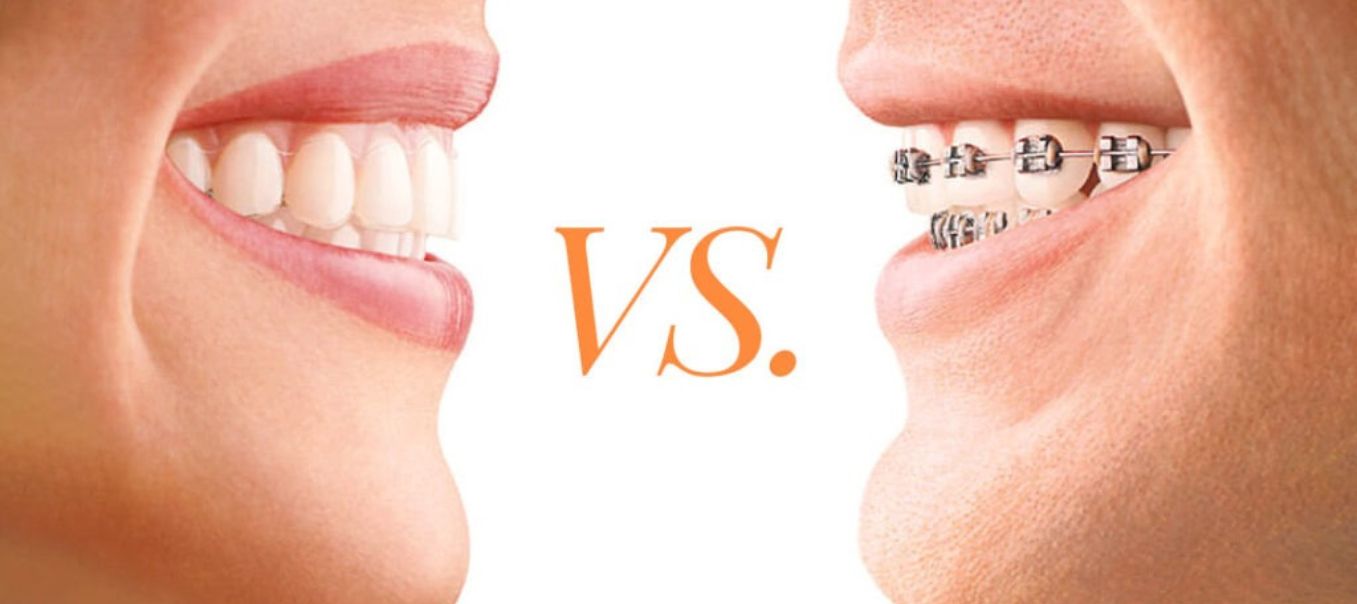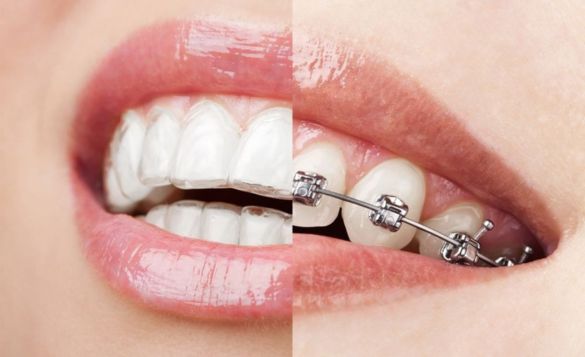
Archives
Categories


Are you considering getting braces or Invisalign to straighten your teeth but unsure about the cost? Well, you’ve come to the right place. In this article, we’ll break down the cost differences between braces and Invisalign, helping you make an informed decision about which option is best for you.
Braces are a traditional orthodontic treatment that uses metal brackets and wires to gradually move your teeth into the desired position. The brackets are cemented onto each tooth, and the wires are adjusted periodically to apply gentle pressure, guiding the teeth into alignment. Braces are highly effective in treating a wide range of orthodontic issues, including crowded teeth, gaps, overbite, underbite, and crossbite.
One of the advantages of braces is their affordability. Traditional braces usually cost between $3,000 and $7,000, depending on the complexity of the case and the location of the dental office. This makes braces a popular choice for individuals who are looking for a cost-effective treatment option.

However, braces do have some drawbacks. The metal brackets and wires can cause discomfort and irritation in the mouth, especially during the initial adjustment period. They can also be more noticeable and affect the aesthetics of your smile. Additionally, braces require regular visits to the orthodontist for adjustments and maintenance throughout the treatment duration.
Invisalign is a modern orthodontic treatment that uses a series of clear, removable aligners to straighten your teeth. These aligners are custom-made for each patient and are virtually invisible when worn. Invisalign is an excellent choice for individuals who want a discreet and comfortable orthodontic treatment option.
Invisalign aligners are made of a smooth, BPA-free plastic material that is comfortable to wear and does not cause irritation. They are removable, which means you can take them out to eat, drink, brush, and floss. This makes it easier to maintain good oral hygiene throughout the treatment process.
The cost of Invisalign is slightly higher than traditional braces, with prices ranging from $3,000 to $8,000. The exact cost depends on factors such as the complexity of the case, the location of the dental office, and the number of aligners required. Despite the higher cost, many individuals prefer Invisalign for its aesthetic appeal and convenience.
When comparing the cost of braces and Invisalign, it’s important to consider the overall treatment duration. Braces are typically worn for an average of 18 to 36 months, depending on the severity of the case. In contrast, Invisalign treatment usually lasts for 12 to 18 months, although this can vary depending on individual cases.
Although braces are generally less expensive upfront, the longer treatment duration can result in additional costs for adjustments and maintenance appointments. Invisalign, on the other hand, may have a higher initial cost but can save you money in the long run due to the shorter treatment duration.
It’s also worth noting that some orthodontists offer discounts or payment plans for both braces and Invisalign to make the treatment more affordable for patients. It’s always a good idea to discuss the cost and payment options with your orthodontist to find a solution that fits your budget.

The cost of orthodontic treatment can vary based on several factors. These include:
Complexity of the case: The more severe the orthodontic issues, the higher the cost is likely to be. Cases that require more extensive treatment and longer treatment duration may come with a higher price tag.
Location of the dental office: The cost of orthodontic treatment can vary depending on the geographic location. Orthodontic services in urban areas or areas with a higher cost of living tend to be more expensive compared to rural areas.
Experience and expertise of the orthodontist: Orthodontists with more experience and expertise may charge higher fees for their services. It’s important to choose a qualified and reputable orthodontist to ensure optimal results.
Additional treatments or procedures: In some cases, additional treatments or procedures may be necessary to achieve the desired results. These can include extractions, jaw surgery, or the use of adjunctive appliances. These additional treatments can add to the overall cost of orthodontic treatment.
Dental insurance plans often offer coverage for orthodontic treatment, including both braces and Invisalign. However, the extent of coverage may vary depending on the insurance provider and the specific plan.
Most dental insurance plans cover a portion of the cost of orthodontic treatment, up to a certain limit. This means that you may still be responsible for a percentage of the treatment cost, even with insurance coverage. It’s important to review your insurance policy and speak with your insurance provider to understand the details of your coverage.
If your insurance does not cover the full cost of braces or Invisalign, you may be able to utilize a Flexible Spending Account (FSA) or a Health Savings Account (HSA) to pay for the treatment with pre-tax dollars. These accounts allow you to set aside money specifically for healthcare expenses, including orthodontic treatment.

If the cost of braces or Invisalign is a concern, many orthodontic offices offer financing options to help make the treatment more affordable. These financing plans allow you to spread out the cost of treatment over a period of time, making it easier to manage your budget.
Some common financing options include:
Monthly payment plans: Many orthodontic offices offer monthly payment plans allowing you to pay for the treatment in installments throughout the duration. These payment plans often come with low or no-interest options, making them a convenient choice for many patients.
Orthodontic-specific financing companies: Several financing companies specialize in providing financing options for orthodontic treatment. These companies offer flexible payment plans tailored to the needs of orthodontic patients.
Before committing to any financing option, it’s important to review the terms and conditions, including interest rates, fees, and any potential penalties for early repayment. Make sure to choose a financing plan that best suits your financial situation and preferences.
Braces offer several advantages and disadvantages that are worth considering when deciding on orthodontic treatment.
Pros of braces:
Cost-effective: Braces are generally the more affordable option upfront, making them a popular choice for individuals on a budget.
Effective for complex cases: Braces are highly effective in treating a wide range of orthodontic issues, including severe crowding, bite problems, and jaw misalignment.
No compliance required: Unlike Invisalign, braces are fixed onto the teeth and do not require any compliance from the patient. This can be beneficial for individuals who may struggle with wearing removable aligners consistently.
Aesthetic concerns: The metal brackets and wires of braces can be more noticeable and affect the aesthetics of your smile.
Discomfort and irritation: Braces can cause discomfort and irritation in the mouth, especially during the initial adjustment period. This discomfort may persist throughout the treatment duration.
Maintenance and adjustments: Braces require regular visits to the orthodontist for adjustments and maintenance, which can be time-consuming.
Invisalign offers its own set of advantages and disadvantages, which should be taken into account when considering orthodontic treatment options.
Aesthetic appeal: Invisalign aligners are virtually invisible when worn, making them a popular choice for individuals who desire a discreet treatment option.
Comfortable and removable: Invisalign aligners are made of a smooth, comfortable material that does not irritate. They are also removable, allowing for easy eating, drinking, brushing, and flossing.
Shorter treatment duration: Invisalign treatment usually takes less time compared to traditional braces, with an average treatment duration of 12 to 18 months.
Cost: Invisalign tends to be slightly more expensive than braces, although the exact cost depends on individual cases and treatment duration.
Compliance required: Invisalign aligners must be worn consistently for optimal results. Failure to comply with the recommended wear time can prolong the treatment duration and affect the outcome.
Limited efficacy for complex cases: While Invisalign can effectively treat many orthodontic issues, it may not be suitable for complex cases that require more extensive tooth movement or jaw realignment.
In the debate between braces and Invisalign, cost is a significant consideration. While braces often offer a lower upfront expense, other factors like treatment duration, comfort, and aesthetic preferences play crucial roles. Consulting with an orthodontist can provide personalized guidance tailored to your needs and budget. Ultimately, investing in orthodontic treatment, whether with braces or Invisalign, yields a confident smile and enhanced oral health. Take the time to evaluate the pros and cons of each option, ensuring your decision aligns with your desired outcome for a radiant smile that lasts a lifetime.
The choice between braces and Invisalign depends on individual preferences, treatment goals, and orthodontic needs. Braces are fixed metal or ceramic brackets attached to teeth, while Invisalign uses clear aligners. Both can effectively straighten teeth, but Invisalign offers a more discreet option.
In general, braces tend to have a lower upfront cost compared to Invisalign. However, the total cost may vary depending on factors such as treatment duration, complexity of the case, and geographic location.
While Invisalign offers many advantages, it also has some disadvantages. These may include:
Compliance: Invisalign aligners need to be worn for 20-22 hours a day, which requires discipline and commitment.
Not suitable for severe cases: Invisalign may not be suitable for complex orthodontic issues that require more precise control over tooth movement.
Discomfort: Some people may experience discomfort or irritation from the aligners, especially when starting a new set.
Both braces and Invisalign can effectively close gaps between teeth. The choice between the two depends on factors such as personal preference, treatment goals, and the recommendation of your orthodontist.
Our website uses cookies to improve your experience. Learn more about: Cookie Policy
Leave a Reply